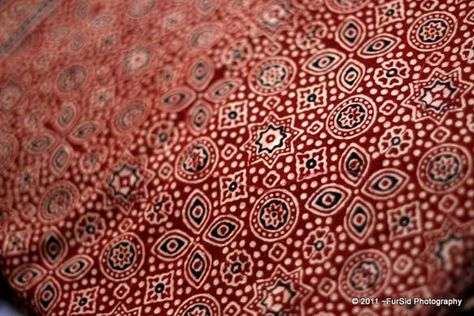In the heart of Pakistan’s southern province of Sindh lies a captivating tradition that dates back centuries: the art of Ajrak making. Ajrak, a splendid textile adorned with intricate patterns and vibrant colors, holds deep cultural and historical significance. This traditional craft is more than just a piece of fabric; it’s a testament to the creativity, skill, and heritage of the Sindhi people.


The Intricate Process
Ajrak making is an intricate and labor-intensive process that involves multiple steps, each requiring a meticulous approach. While the techniques might have evolved over time, the essence of the craft remains unchanged.
- Preparation of the Cloth: The process starts with washing and dyeing the fabric, typically cotton, to ensure it’s ready to absorb the vibrant dyes.
- Block Printing: One of the defining features of Ajrak is its block-printed patterns. Artisans carve intricate designs onto wooden blocks, creating patterns that are both symmetrical and mesmerizing. These blocks are then used to apply the dye to the fabric.
- Natural Dyeing: Ajrak is known for its earthy colors, achieved through the use of natural dyes. The most common colors are shades of blue and red, obtained from indigo and madder roots, respectively. These dyes are mixed in various proportions to create a spectrum of hues.
- Resist Printing: One of the most fascinating aspects of Ajrak making is the resist printing technique. By applying a resist paste made from clay, gum, and wheat, the artisan ensures that specific areas of the fabric remain untouched by the dye, resulting in intricate and mesmerizing designs.
- Sun Drying and Washing: After dyeing, the fabric is sun-dried to set the colors. Subsequently, it’s washed multiple times to remove excess dye and the resist paste, leaving behind the brilliantly patterned Ajrak fabric.
- Finishing Touches: Skilled artisans then add final details, often in the form of hand-stitched embroidery or additional block-printed motifs.
Cultural Significance
Ajrak holds deep cultural and spiritual meaning for the Sindhi people. It’s not just a textile; it’s a symbol of identity, pride, and resistance. In the Sufi tradition, Ajrak is worn as a mark of humility and respect for the Earth. It’s also used to express unity and harmony among different ethnic groups in Sindh.
Preserving Tradition in Modern Times
Despite the challenges posed by modernization and globalization, the art of Ajrak making has managed to retain its essence and relevance. Organizations and artisans in Sindh have come together to ensure the survival of this traditional craft. Workshops, exhibitions, and collaborations with contemporary designers have helped to not only preserve the craft but also introduce it to a wider audience.
Conclusion
The art of Ajrak making in Sindh is more than just a craft; it’s a living connection to the region’s history, culture, and spirituality. The intricate process, rich symbolism, and stunning aesthetics of Ajrak have transcended time and continue to capture the hearts of those who appreciate the beauty of tradition. As we celebrate this remarkable craft, let us also recognize the dedication of the artisans who tirelessly carry forward the legacy of Ajrak making, ensuring that this invaluable tradition remains vibrant for generations to come.


Comments (3)